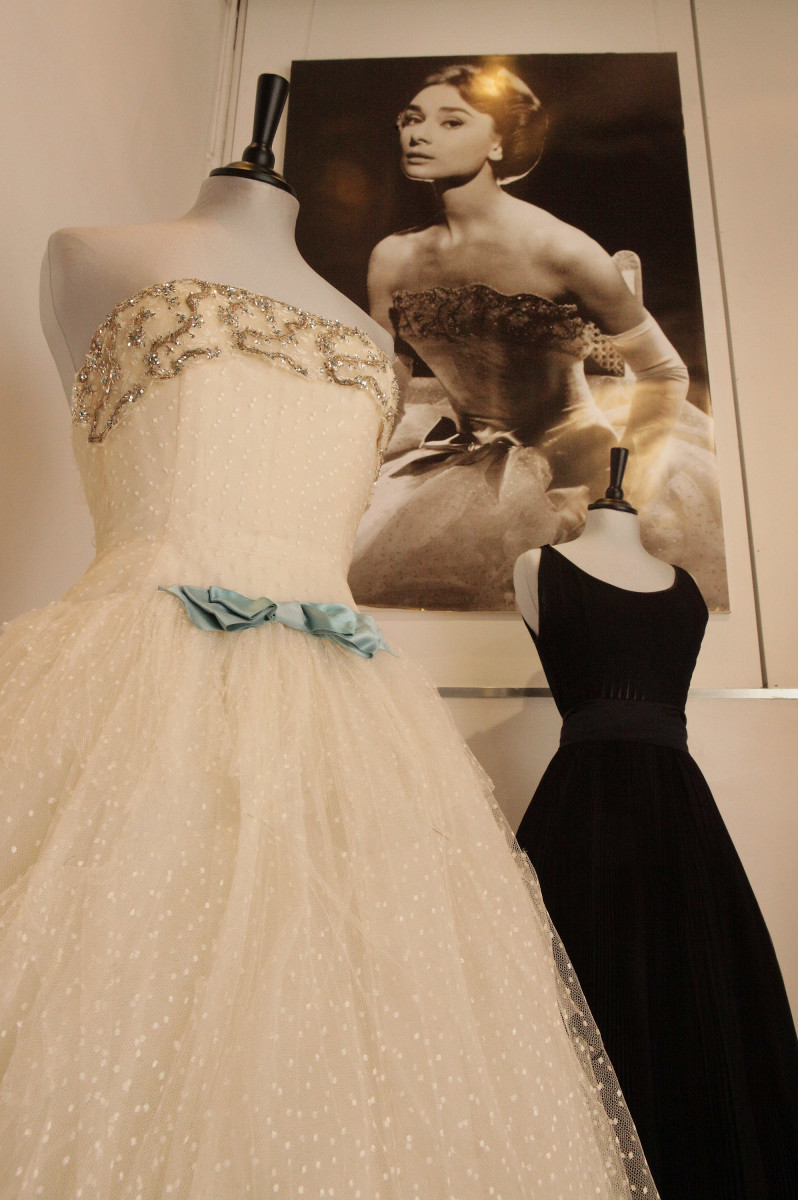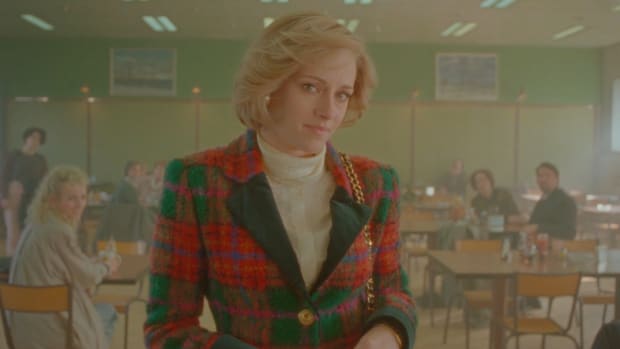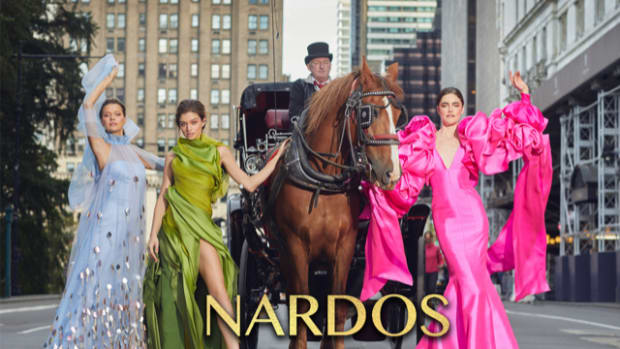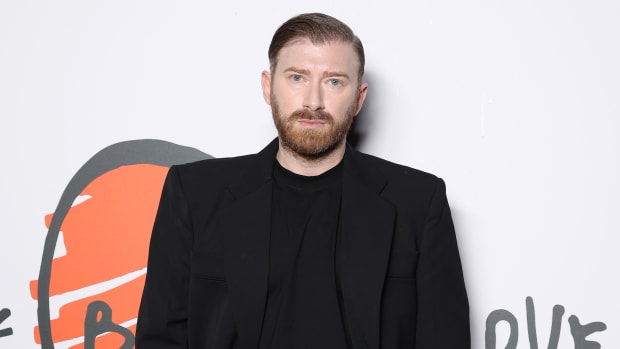In "Spencer," Kristen Stewart makes her first transformative appearance as Princess Diana by driving unaccompanied to a Royal Family Christmas at Sandringham. The top of her Porsche Carrera is down, the cold wind is
whipping through her hair. She dons her oversized wayfarer-style sunglasses — and amid her feathered blonde waves, you get a glimpse of a dainty gold double-C logo: Chanel.
Lost, Diana pulls over to a roadside café. She exits the car in an aristocratic wool and velvet plaid blazer and pencil skirt custom-made by two-time Oscar-winning costume designer Jacqueline Durran, and grabs her quilted flap bag — by Chanel.
While the real Princess Diana did wear Chanel, it was only after the time period covered in the Pablo Larraín film. She then reportedly stopped wearing the label after her divorce in 1996, as its famous logo reminded her of Prince Charles and longtime love, Camilla Parker-Bowles (also foreshadowed in season four of "The Crown").
In terms of storytelling, lavish designer accessories make sense as effortlessly aspirational accoutrements that, say, a style icon princess would wear. But there's also the fact that Stewart has been a Chanel brand ambassador since 2013, continuously making headlines for wearing looks from the French fashion house on the red carpet and to its shows.
Of course, brands dressing muses on the silver screen isn't a new concept — it dates back to the early days of Hollywood, with Hubert de Givenchy (somewhat controversially) designing dresses for Audrey Hepburn to wear in "Breakfast at Tiffany's," "Sabrina” and "Funny Face," which were all costume designed by Edith Head, and Coco Chanel outfitting friend and confidante Romy Schneider in the Italian romance anthology "Boccaccio 70" (with the actor's "Il Lavore" ensemble designed by Piero Tosi). But in an age of integrated marketing and branded content, age-old alliances take on a new meaning — especially for the costume designers, and for the fashion legacy left behind on an Instagram grid or even within our own closets.

The Givenchy white point d'esprit ball gown (left), which Audrey Hepburn wore in the 1956 film 'Love in the Afternoon.'
Photo: Peter Macdiarmid/Getty Images
"There's a lot of value to it,” says Marc Beckman, founding partner and CEO of DMA United, a luxury fashion branding, advertising and representation agency with a client list including Karl Lagerfeld, Tom Ford and Carhartt, plus entertainment entities like Sony Music and Warner Bros. A lawyer by training, he explains that fashion houses ideally would have the rights to repurpose any captured content — video clips or still shots of an actor wearing the brand in the film — to disseminate across its "owned, earned and paid for media," from social posts to multi-media advertising campaigns.
"They get cultural relevancy in real time through the association and affiliation with the film, and everybody needs content these days," he says. "So if you're getting in with such a high value production, it's great for companies."
The proof is in the pudding, so to speak: According to online marketplace Love the Sales, global searches for Chanel increased 44% immediately following the November 5 premiere of "Spencer." In ensuing weeks, global searches for "Chanel flap bags" grew 50%, with searches for "Chanel sunglasses" jumping 174% and for "Chanel blazers" spiking a whopping 380%.
Studios may look to get a fashion house involved in a film via the star as another way to pad box office receipts (or boost streaming subscription numbers), to harness its following, who, hopefully, will spend.
"These fashion brands and luxury houses, they bring real audiences. They bring eyeballs. They bring viewers. Content creators don't necessarily do that," Beckman says. "There are a lot of content creators out there today, whether it's video, written word or photography, but it doesn't necessarily mean that the audience will be there."
Going back to era of Hepburn in Givenchy, an actor also might've wielded a higher level of control over what they'd wear in a movie. In 1962's "What Ever Happened to Baby Jane," stars Bette Davis and Joan Crawford were granted final costume approval, as detailed in Shaun Considine's book "Bette and Joan: The Divine Feud." But Beckman — who creates partnerships, endorsements and strategic alliances between fashion brands and entertainment entities at DMA — suggests that the authority could reach farther due to actors' contracts with the house.
"[The actors] agree to use the brands in specific places that can range from the red carpet, all the way through, even, integration into films," he says.
President of the Costume Designers Guild (CDG) and industry veteran Salvador Perez ("Never Have I Ever," "Sex Lives of College Girls," "Pitch Perfect"), though, is skeptical: "I've never heard of that." (A PR representative for "Spencer" confirmed that there was no contractual obligation for Stewart to wear Chanel in the film. Chanel declined to comment for this story.)
However, Perez does acknowledge that working with a fashion label, especially a luxury one, has one big benefit for costume designers. "You have access to a brand you probably wouldn't get before," he says. There are also the expensive archives and handiwork of the haute couture workroom, which could help costume designers expand their wardrobes on limited funds, especially when telling an aspirational story like "Spencer." (Larraín's film had a production budget of $18 million, compared to, say, the pre-marketing $200 million one of Marvel's "The Eternals.")
In the case of "Spencer," Chanel also provided financial backing to the movie. The brand's first foray into film financing came in 2014, for the also-Stewart-starring "Clouds of Sils Maria." (The "All About Eve"-esque project also features a cameo by Karl Lagerfeld muse and frequent Chanel runway model Caroline de Maigret playing a fashion publicist.) At the time, Chanel president of fashion Bruno Pavlovsky toldWWD: "Chanel has always had privileged relationships with a number of artists and these relationships, beyond providing them with the means to carry out their projects, have often resulted in direct patronage of these artists."
Since then, Chanel continued financing and providing archival access to synergistic art house projects starring Stewart, including 2016's "Personal Shopper."
While Tessa Thompson isn't an official ambassador for the brand, her friend-of-the-house status with Chanel did help "Sylvie's Love" costume designer Phoenix Mellow with access to its contemporary archives.
Recommended Articles

In 'Sylvie's Love,' Tessa Thompson's character, Sylvie, in a Chanel gown (right).
Photo: Courtesy of Amazon
A vintage collector and FIT alum, Mellow initially reached out directly to the brand for Thompson's wardrobe in Eugene Ashe's '60s set, Sirkian-style romantic drama, meticulously studying the last decade of Chanel runways to compile a tight and precise wish list of pieces that fit the Old Hollywood-referential feel of the film. In the end, she outfitted Thompson in three Chanel looks, while creating approximately 50 period costumes for the titular TV producer character. One of the them was a cerulean blue Chanel Resort 2011 gown (above) which Mellow exquisitely reimagined as a mod empire-waisted style for a romantic reconnection scene. Accented with mid-century details by Mellow and set against the vintage yellow New York City taxi cab, it made for a striking cinematic scene featured on the movie's posters.
Disney's live-action "Cruella" features another anachronistic fashion integration between a brand and its lead actor: Emma Stone, a face of Louis Vuitton since 2017. Two-time Oscar winning costume designer Jenny Beavan masterfully blended a Capucines bag, which debuted in Fall 2013, into a posh '70s ensemble worn by grifter Estella (Stone, below) disguised as a London sophisticate.
In a lead up to the movie's premiere, Louis Vuitton promoted the sighting on Instagram and released a short video featuring Beavan and Stone. (Representatives for Louis Vuitton and Beavan declined to comment on the collaboration.) Love the Sales found that global search for the Capucines bag increased 33% following the May 28 release of "Cruella" on Disney +.
Clear communication between all parties involved — studio marketing, producers, brand PR and the costume department — is productive, if not crucial, to a smooth filmmaking process. If not, in certain product-integration situations, costume teams may need to trouble-shoot and reallocate precious time and resources at the last minute to adapt a discordant item into, say, a period piece or fantasy genre.
"It just makes everything harder," says Perez. He gives a hypothetical example of a brand supplying only one gown for an explosion scene, which actually requires 20 versions of the same dress: "Then we have to make multiples for action."
"The studio gets the PR [from the brand], and they think they're giving us something, but it just adds more work to our load," he continues. "At a certain point, it's like, 'Why bother?' When I'm gonna do all this work to make [the costume] work and then it's called 'the Prada dress.'"
Therein lies the fundamental risk of a brand involvement in a film. Of course, name-dropping a famous label makes for effective PR and marketing for both the brand and the studio. "It becomes a problem when, publicity-wise, it becomes all about one designer dress, when the costume designer did the entire movie,” says Perez, his voice rising, emphasizing the extensive effort it takes to outfit not just the leads, but also the supporting cast and background, often involving bespoke creations. Brands can rely on their "huge branding machine" apparatus to publicize involvement in the film, but they often neglect to mention the costume designer; resulting clickbait-y headlines latch onto the brand and associated movie star, while the costume designer's work gets lost in the mix.
Perez recalls when, earlier this year, a high-end brand's press release took full credit for designing nine gowns in a film. The missive completely omitted the name and involvement of the costume designer, who created over 70 costumes for just the lead.
“We called them out publicly [on social media], and then they were like, 'Oh, oops,' and they changed it from there," he says. "The brands want the exposure and the notoriety, but they forget that we're heavily involved in the process, because we're not as big as they are."
The CDG marketing committee is planning a town hall to help educate its members on controlling the narrative in collaborating with fashion brands. Perez continuously encourages members to be active on their own social media, to create their own platform and own the credit. The union also launched a campaign titled #CreditCostumeDesigners to call out brands — and publications — on social media who erase their contributions.
Brand involvement can also hit costume designers where it really hurts: their income. Beckman, who also negotiates apparel licensing arrangements for studios, expresses excitement over burgeoning out-of-the-box ways that brand and film collaborations can extend their market reach and boost profits, enthusiastically listing the top two: immersive experiential events "beyond pop-ups" and "inspired-by" movie-themed collections.
But that's also when the costume designers are left out. It's happening already through licensing — just look at the constant roll-out of Netflix production-themed designer collaborations. Another example: In conjunction with the May release of "Cruella," Disney partnered with Rag & Bone — which was not featured in the film — to release a capsule influenced by Beavan's punked-out couture costumes. But she wasn't included in any negotiations or merchandising profits, and wasn't even notified of the collab. "The thing about 'Cruella' is that you've got a film about fashion, about two fashion designers. The whole story is them almost having a war using fashion. So, that's so disrespectful to then bring out fashion lines," Beavan toldVariety in June.
During production, studio consumer products departments may lurk about the costume department taking notes on sketches, fabrications and ultimate designs to then pitch licensing opportunities. "The risk for us is that we're taken out of the equation," says Perez. "That's where it gets insulting. I put my blood sweat and tears into this project and work for hours, don't disrespect me. It's about respect." The CDG marketing committee has also been holding discussions on how to negotiate future contracts with the studios.

Stewart (left) in 'Spencer' in a Chanel gown, remade by the haute couture workroom, for the film costume designed by Durran.
Photo: Courtesy of Neon
Ultimately, as Perez points out, maintaining the costume designer's vision is essential to successfully incorporating a brand product into a film, both to support the script and build the characters. Costume designers having the authority to exercise their creative vision and the control of when and where to incorporate products help bring about the successful execution audiences then see on-screen.
When Fashionista previously previously spoke with Durran about her "Spencer" costumes and working with Chanel for one-third of Stewart's looks, she applauded the collaborative experience: "[It was] a great creative partnership, really, because it was exactly that. It was Chanel contributing to the movie rather than us having to use things that weren't appropriate. We just used the things that really worked."
"When it's a true collaboration, they involve us," says Perez.
Never miss the latest fashion industry news. Sign up for the Fashionista daily newsletter.





